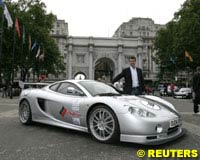

Automotive News and Reviews for the Petrolhead
In this week's issue:
- Car Briefs
- GM to Continue Downsizing Workforce
- Michelin Reinvents Wheel with Airless Tweel
The significance of the concept is that it heralds a new design era at Jaguar. The company has now tacitly admitted that its design direction has been fundamentally misconceived over the last decade. Jaguars have been given universally retro styling in order to reassure the American market that the ethos of the company has not changed under Ford. In fact, the market is bored rigid by retro Jaguars and the company is now looking for a new design philosophy.
The new concept car is said to be in the spirit of the E-Type and original XJ6: a mould-breaking design that becomes iconic. It seems unlikely that the new design will have that much impact (indeed in today's crowded market it is hard to see any car having as much impact as the original E-Type), but it is a very good-looking model. Expect something similar to be on the roads around 2007/2008.
The new model, currently called V8 Vantage, will slot into the range below the V12 DB9. Priced at around £70,000 (€105,000), it is intended to compete with the Porsche 911 and finally take Aston Martin into the mainstream sports car arena.
Final pictures of the car have not yet been released, but are expected to be very similar to the concept car pictured here. The V8 will complete Aston Martin's long planned three-car range (V8, DB9, Vanquish), the most extensive in the company's history.
The KZ-1 is the brainchild of chairman Klaas Zwart, a successful racing driver who has made a fortune in the oil business. Hence the Ascari is not the usual wannabee supercar manufacturer operating on a wing and a prayer. It has a huge new factory in Banbury, in the heart of the UK racing car industry, an established record in motor racing (including Le Mans) and a money-no-object approach to development.
The KZ-1 is meant to be the antidote to oversized, overweight supercars. At around 1300 KG, it is up to 400 KG lighter than its competitors and drives like a giant Lotus Elise. It is powered by a modified BMW M5 V8 producing 500 bhp, enough for a top speed of 200 mph plus.
General Motors, the world's biggest automaker, will keep shrinking its U.S. work force this year, offering buyout packages to more salaried employees to offset rising costs, executives say.
"Since 2000, we have followed the attrition curve," Gary Cowger, president of GM North America, told reporters at a briefing at the North American International Auto Show on Monday.
"This is no different this year than what we've been doing. And it's elective," Cowger added, emphasizing that there are no forced layoffs planned for GM's salaried workers.
Since the end of 2000, GM's North American workforce has dropped from 212,000 to 181,000. In the United States, GM had 150,000 hourly and salaried workers at the end of the third quarter of 2004, down 9,000, or nearly 6 percent, from 159,000 a year earlier.
Last month, the automaker said it would offer buyout packages early this year to some of its 38,000 salaried workers in the United States. GM Chief Executive Officer Rick Wagoner at the Monday briefing denied a local press report that the automaker would cut up to 7 percent of its U.S. workforce this year.
"Seven wasn't my number," Wagoner said, but he declined to give a target for job reductions.
"We're going to continue to try to improve our productivity at the kind of rates we've seen," Wagoner said, referring to the steady downsizing in GM's work force since 2000.
GM plans to lay off about 950 workers at its Linden, New Jersey, plant when it stops making SUVs there early this year, and will also close a van plant in Baltimore, affecting about 1,100 jobs. But GM's hourly workforce has an average age of about 50 and many are nearing retirement, Wagoner said.
Wagoner said the continued job cuts will help improve productivity, even as the U.S. economy grows and GM launches new vehicles this year.
"I think we're moving very well in (new) product," Wagoner said, referring to GM's new car and truck launches. "I think this thing is coming. There's sceptics."
Analysts have forecast that GM's profits will drop in 2005, with weaker earnings from its core North American automotive operations.
Last year, GM lost about 1 percentage point of U.S. market share, and some analysts said the automaker will have a hard time holding share again this year due to high inventories of unsold vehicles and aging lineup of full-size pickup trucks and SUVs.
"Probably the pressure point on volume will come in this battle that we see in the full-size truck business and the full-size utility business," Wagoner said.
Michelin has unveiled an integrated tyre and wheel that runs without air - a concept that the world's biggest tyre maker said could one day boost car performance and make pneumatic tyres obsolete.
The French group said its "Tweel" would make its debut in inventor Dean Kamen's high-tech iBOT wheelchairs and a four-wheel vehicle from Segway called a Centaur. It is still gathering real-world experience for the product in construction equipment, military vehicles and passenger cars.
"In reality we are looking on the order of 10 to 15 years before the concept can be mature enough and well enough integrated into the (passenger) vehicle design," Terry Gettys, head of Michelin's research and development centre in South Carolina, told reporters at the North American International Auto Show on Sunday.
He said radial tyres - which Michelin invented - will be the standard "for a long time to come" and that Michelin would keep rolling out "run-flat" tyres that let motorists keep driving after a puncture.
He stressed it was up to manufacturers to embrace the Tweel concept, which Michelin aimed to develop with industrial partners. Citing research that three of four cars on the road have at least one underinflated tyre, Gettys said the Tweel concept could boost safety and make it much easier to handle running over curbs or potholes.
The Tweel's see-through hub and spoke design make it look like a black rubber wagon wheel. It is nearly as good as standard pneumatic tyres when it comes to fuel economy and improved lateral stiffness means it handles well, Gettys said.
Tweels would cost more to make than standard tyres, but they would eliminate the need for mounting and balancing tyres and let motorists simply replace worn-out tread, he said. In 2003, Michelin held the top share of the global tyre market at 20.1 percent, followed by Bridgestone's 18.4 percent and Goodyear's 16.9 percent.
![]() Car Briefs
Car Briefs
 Jaguar has shown a new concept car at the Detroit car show - the Advanced Lightweight Coupe.
Jaguar has shown a new concept car at the Detroit car show - the Advanced Lightweight Coupe.
 Aston Martin has confirmed that its new smaller model will go into production in summer 2005.
Aston Martin has confirmed that its new smaller model will go into production in summer 2005.
 Ascari has officially launched its new supercar, priced at an awesome £235,000 (€350,000).
Ascari has officially launched its new supercar, priced at an awesome £235,000 (€350,000).
![]() GM to Continue Downsizing Workforce
GM to Continue Downsizing Workforce
![]() Michelin Reinvents Wheel
Michelin Reinvents Wheel
| Contact the Editor |
© 2007 autosport.com . This service is provided under the Atlas F1 terms and conditions.
|
Volume 11, Issue 2
Articles
The Low-Key Approach
Technical Analysis: Toyota TF105
Open Wheel Racing: the Next Generation
Regular Columns
The F1 Trivia Quiz
Bookworm Critique
On the Road
Elsewhere in Racing
The Weekly Grapevine
> Homepage |